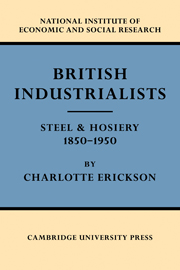Book contents
- Frontmatter
- Contents
- LIST OF TABLES
- Foreword
- Introduction
- I SCOPE OF THE INQUIRY
- II SOCIAL ORIGINS OF THE STEEL MANUFACTURERS
- III CAREERS OF THE STEEL MANUFACTURERS
- IV SOCIAL ORIGINS OF THE NOTTINGHAM HOSIERS
- V CAREERS OF THE HOSIERY MANUFACTURERS
- VI THE INTRODUCTION OF NEW TECHNIQUES IN STEEL-MAKING
- VII HOSIERY INNOVATORS
- VIII THE PUBLIC COMPANY
- Appendix A Selection of firms
- Appendix B List of firms included in steel study
- Appendix C Selection of men for steel study
- Appendix D The hosiery samples
- Appendix E Classification of fathers' occupations
- Appendix F Notes on comparisons with Population Census
- Appendix G Education
- Appendix H Marriages
- Appendix I Careers
- Appendix J Public company tables
- List of Principal Works Cited
- Index of names
- Index of companies
- General index
- PUBLICATIONS OF THE NATIONAL INSTITUTE OF ECONOMIC AND SOCIAL RESEARCH
IV - SOCIAL ORIGINS OF THE NOTTINGHAM HOSIERS
Published online by Cambridge University Press: 07 October 2011
- Frontmatter
- Contents
- LIST OF TABLES
- Foreword
- Introduction
- I SCOPE OF THE INQUIRY
- II SOCIAL ORIGINS OF THE STEEL MANUFACTURERS
- III CAREERS OF THE STEEL MANUFACTURERS
- IV SOCIAL ORIGINS OF THE NOTTINGHAM HOSIERS
- V CAREERS OF THE HOSIERY MANUFACTURERS
- VI THE INTRODUCTION OF NEW TECHNIQUES IN STEEL-MAKING
- VII HOSIERY INNOVATORS
- VIII THE PUBLIC COMPANY
- Appendix A Selection of firms
- Appendix B List of firms included in steel study
- Appendix C Selection of men for steel study
- Appendix D The hosiery samples
- Appendix E Classification of fathers' occupations
- Appendix F Notes on comparisons with Population Census
- Appendix G Education
- Appendix H Marriages
- Appendix I Careers
- Appendix J Public company tables
- List of Principal Works Cited
- Index of names
- Index of companies
- General index
- PUBLICATIONS OF THE NATIONAL INSTITUTE OF ECONOMIC AND SOCIAL RESEARCH
Summary
Nottingham's hosiery manufacturers have differed greatly from the steel manufacturers in social origin. In every period studied the hosiery industry has drawn a smaller proportion of its businessmen from Social Class I. Furthermore, the hosiery industry has shown a greater response to changing industrial circumstances in the social recruitment of its leaders than has the steel industry. In contrast to the stable and even rigid social composition of steel leaders through most of the industry's history, each of our five hosiery samples differs significantly from the ones before and after it with respect to the social origins of its leaders. This small-scale, highly competitive industry offers more support for Marshall's theory of opportunity for humble men during periods of change than does the steel industry.
THE HOSIERY INDUSTRY ON THE EVE OF THE FACTORY
The method used in the hosiery study affords an opportunity to compare the social composition of leaders in an industry before the application of power with that of the early factory manufacturers. In 1840 there were no steam-powered hosiery factories in the Nottingham region. The industry was still organized entirely on the domestic system. It was, as its historian has described it, a ‘stagnant’ industry, and far from prosperous.
The capitalist in the domestic hosiery industry was the merchant hosier who supplied yarn to be knitted, owned many of the frames on which his goods were made up, although they stood in the workers' homes or in small workshops, and marketed the finished goods.
- Type
- Chapter
- Information
- British IndustrialistsSteel and Hosiery 1850–1950, pp. 79 - 122Publisher: Cambridge University PressPrint publication year: 1959



